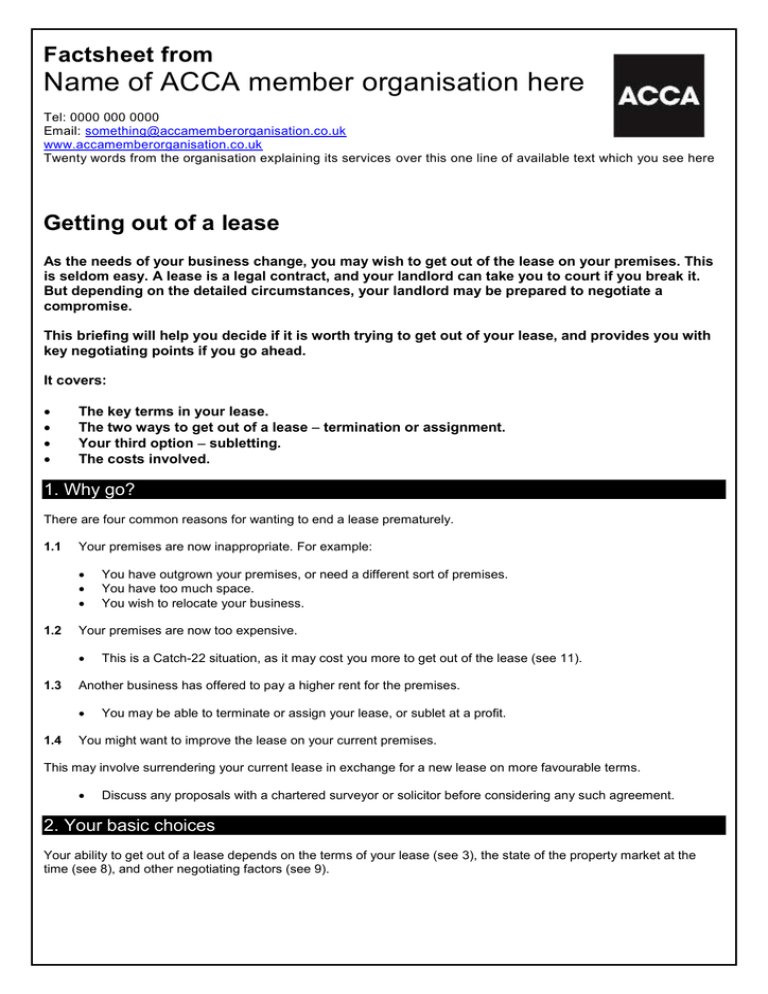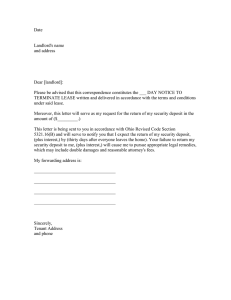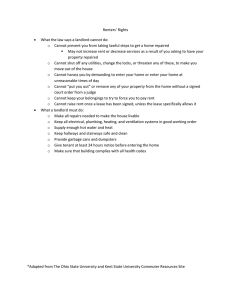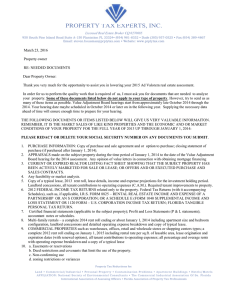
Factsheet from
Name of ACCA member organisation here
Tel: 0000 000 0000
Email: something@accamemberorganisation.co.uk
www.accamemberorganisation.co.uk
Twenty words from the organisation explaining its services over this one line of available text which you see here
Getting out of a lease
As the needs of your business change, you may wish to get out of the lease on your premises. This
is seldom easy. A lease is a legal contract, and your landlord can take you to court if you break it.
But depending on the detailed circumstances, your landlord may be prepared to negotiate a
compromise.
This briefing will help you decide if it is worth trying to get out of your lease, and provides you with
key negotiating points if you go ahead.
It covers:
The key terms in your lease.
The two ways to get out of a lease termination or assignment.
Your third option subletting.
The costs involved.
1. Why go?
There are four common reasons for wanting to end a lease prematurely.
1.1
Your premises are now inappropriate. For example:
1.2
Your premises are now too expensive.
1.3
This is a Catch-22 situation, as it may cost you more to get out of the lease (see 11).
Another business has offered to pay a higher rent for the premises.
1.4
You have outgrown your premises, or need a different sort of premises.
You have too much space.
You wish to relocate your business.
You may be able to terminate or assign your lease, or sublet at a profit.
You might want to improve the lease on your current premises.
This may involve surrendering your current lease in exchange for a new lease on more favourable terms.
Discuss any proposals with a chartered surveyor or solicitor before considering any such agreement.
2. Your basic choices
Your ability to get out of a lease depends on the terms of your lease (see 3), the state of the property market at the
time (see 8), and other negotiating factors (see 9).
2.1
There are two ways out of a lease.
You agree a termination of the lease, usually avoiding any ongoing liabilities to the landlord (see 4).
You find a tenant to replace you, and assign the lease to this third party.
This will probably leave you with some liabilities to the landlord (see 5).
2.2
An alternative is to sublet the premises.
You find a tenant to replace you, in order to generate your own rental income.
All your liabilities to the landlord under the head-lease remain. The sub-tenant is liable to you under a separate
sub-lease (see 6).
If your lease is due to end in less than two years, it is usually preferable to terminate the lease, avoiding the
considerable expense and risk of assigning or sub-letting. Or, having considered all the costs involved (see
11), it may be best to remain in the premises until the lease expires.
3. Your lease
Ask your solicitor or a chartered surveyor to review your lease agreement and explain your options.
3.1
The existence of break clauses gives you the automatic right to terminate the lease at specified dates.
For example, a nine-year lease might have break clauses which allow the tenant to terminate the lease after
three or six years.
You still have a problem if you wish to get out of the lease before the specified date.
3.2
The lease may give you the right to assign the lease or sublet to another tenant, with or without various
restrictions.
3.3
If you do not have these rights in the first place, you may be able to negotiate these rights at a later stage
at a price.
Some leases are more flexible than others.
The shorter your lease, the easier it should be to get out of. It may be possible to negotiate a deal with the
landlord by paying him some or all of the outstanding rent.
Over the last ten years, leases have become shorter, more flexible and generally far more favourable to
tenants.
An occupational lease (or standard or institutional lease) is difficult to get out of.
The lease typically runs for 12 to 25 years and has strict legal restrictions since it can be traded on the property
market.
If you own a long leasehold of 99 years or more, it is similar to owning the freehold of the property. Usually you
can sell a long leasehold premises as you would a freehold.
3.4
Take any opportunities that arise to improve the terms of your lease.
For example, when your lease comes up for review, try to negotiate better terms in return for any increase in
rent.
Your professional adviser can tell you what the best course of action is and how much the whole process is likely
to cost.
4. Terminating the lease
2
4.1
Exercise a break clause in your lease contract, if there is one.
4.2
You usually have to notify the landlord in writing during a fixed notice period. Ensure you do not miss the
deadline.
The landlord may be legally entitled to refuse to accept the break if you breach any of the terms of your
lease, however minor for example, if the rent is in arrears.
Check your lease for any penalties.
In the absence of a break clause, offer your landlord a deal based on the current market conditions to surrender
your lease (see 8).
The landlord is under no obligation to agree to any proposal you make.
If the landlord realises you are desperate to move, you may end up paying a premium to leave.
If you are in financial difficulties, you may only be asked to pay a relatively small penalty payment.
You will have to prove your position to the landlord. Be prepared to reveal financial information relating to your
business.
(If nothing else, the landlord may agree to a lower rent if it is clear that your business will fail otherwise. A lower
income is often better than a vacant property.)
Your negotiating position should be much stronger if you can find another business to take on the lease
especially if its financial standing is better than yours.
5. Assigning the lease
5.1
Assigning a lease (passing it on to another business) is a halfway step between terminating the lease and
subletting.
Short leases often prohibit assignment of the lease. It may also be prohibited in the last few years of a lease.
Even if assignment is permitted, the lease will restrict who the new tenant can be.
You are likely to need the landlord's consent, but the landlord cannot unreasonably withhold consent.
The key issue is whether the financial standing (covenant) of the new tenant is as good as yours.
The landlord will usually want to check the prospective tenant’s accounts and references.
The permitted use of the premises may be restricted in a way that disqualifies the proposed new tenant.
The landlord will want to know how the new tenant will use the premises, and to be told of any planned
alterations.
5.2
Although the new tenant (assignee) is liable to the landlord to fulfil the terms of the lease, you may be left with
some liabilities.
One way or another, you usually guarantee the new tenant's payments.
It is usually the date of the lease that matters.
For leases beginning before 1 January 1996, you usually remain liable to the landlord for all payments owed
by any subsequent tenants, throughout the full period of the lease. (This is the infamous ‘Privity of Contract’
law.)
If you obtain your premises by taking an assignment of a pre-1996 lease, you are bound under the pre-1996 law.
For leases beginning after 1 January 1996, the landlord will usually be entitled to require you to guarantee
payments by the next tenant (but not all subsequent tenants), failing which the landlord may be entitled to
refuse to let you assign the lease.
3
In either case, the landlord can only claim payments of rent and other fixed sums within six months of the sums
becoming due and provided the landlord has given notice to the former tenant.
You may have to pay a one-off premium to the new tenant, if the rent under the lease is above the current market
rate. Conversely, if the rent is below the market rate the new tenant may be happy to pay you a premium in
which case you should consider whether you need to opt to tax and charge VAT to protect your position.
6. Subletting your premises
If you sublet, you become the landlord of the incoming tenant.
6.1
You remain liable to your landlord under the original lease (the head-lease).
6.2
You negotiate a new lease with the new tenant (the sub-lease).
6.3
Check the terms of the existing lease to establish what you can and cannot do.
The terms of the sub-lease are usually similar to the terms of the head-lease, to cover all your liabilities.
You cannot give any rights to the new tenant which extend beyond your own rights as a tenant for
example, you cannot give a longer lease.
Even if you cannot cover your rent, subletting may at least cover other overheads such as rates and service
charges.
You may be able to make a profit on the rent and other charges.
To protect your reclaims of any VAT paid to the landlord you should carefully consider your own VAT
arrangements.
Landlords usually want to approve the terms of a sub-lease before consenting.
7. Finding a tenant
Unless you already know of a suitable tenant who would like to take your premises, you will need to employ a firm of
chartered surveyors.
7.1
Ask for proposals from three firms and pick the one you have most confidence in.
7.2
Check the terms of engagement. These give details of the commission payable and the proposed expenditure on
marketing.
7.3
The proposal should outline plans for marketing the premises, including views on what the rent should be
and how long the whole process will take.
Which marketing costs will you have to pay and at what stage?
What additional costs will be added to the bill?
Will the surveyors bring in other agents (at no cost to you) if they have difficulties finding a tenant to take
your lease?
Provide the surveyors with full information on the premises.
This should include floor plans and details of the lease, the fixtures and fittings, and any costs such as
service charges.
8. Market conditions
Market conditions will determine how easy your negotiations with the landlord are, particularly if you are negotiating to
terminate the lease early.
8.1
If the property market is strong (and rents and occupancy rates are high), your landlord is more likely to agree a
4
deal.
8.2
In these conditions, the landlord can expect to find a new tenant soon and perhaps to increase the rent.
You may even be able to negotiate a cash premium for leaving the premises.
If the property market is weak (and rents and occupancy rates are low), your landlord may be extremely reluctant
to agree a deal.
You may have to pay a financial penalty to get out of the lease.
9. Your negotiating position
Take steps to strengthen your negotiating position by assessing the situation from a number of different angles.
9.1
What is your landlord’s position?
The premises may be difficult to re-let, because of location, layout or condition.
The landlord may have other problems.
If your premises are in a multi-let building, find out if the landlord plans future redevelopment for the whole
building.
If this is so, it will be easier to negotiate a termination. It should also be cheaper, as you can avoid any
dilapidation charges.
9.2
Has the landlord broken any terms of the lease?
9.3
For example, if the landlord fails to maintain the premises, you may have the right to terminate the lease
(once notice periods and legal procedures have been completed).
What concessions are you willing to make?
If you provide any guarantees (see 5.2), try to limit the amount and duration.
It is often worth paying more cash today to avoid potentially large future liabilities.
10. Avoiding disputes
It is not always possible to avoid disputes, but you can take steps to minimise the risks.
10.1 Ensure you understand and agree with all the clauses in the lease before signing it.
Use a professional adviser to explain all the terms and obligations.
Ensure you do not breach any of the terms in the lease and follow the correct procedures when exercising
your rights
10.2 Agree a procedure for resolving disputes. Get it included in the lease before you sign.
You can agree how formal the procedures should be and who should act as the arbitrator or mediator.
It can be cheaper, quicker and more flexible to resolve disputes this way.
Ask your Trade Association if there is an arbitration scheme for your industry.
Contact the Chartered Institute of Arbitrators (020 421 7444 or www.arbitrators.org).
Some courts offer mediation facilities.
In the event that you still cannot reach agreement, courts are generally sympathetic to the difficulties faced by
tenants.
11. What will it cost?
5
The costs incurred in getting out of your lease may make your annual rent look cheap by comparison.
Be realistic about the price you will have to pay.
11.1 Do not ignore the cost of the professional advisers involved, on both sides.
Note that the bills for your landlord’s advisers will usually be paid by you.
The cost of finding a new tenant may be hard to estimate in advance.
11.2 What is the extent of your liability under the lease for dilapidation charges?
11.3 How much is finding new premises and relocating going to cost you?
The property industry has produced a code of practice for tenants and landlords in England and Wales to follow when
negotiating commercial leases.
To obtain a copy, visit
http://www.bpf.org.uk/en/files/bpf_documents/commercial/Code_of_practice_for_commercial_leases.pdf
When moving premises, plan the move at least six months ahead.
Expert contributors
Thanks to Melanie Lord (AVS VAT, 08700 770044).
Last updated 01.06.11
© Atom Content Marketing 2011. ISSN 1369-1996. All rights reserved. No part of this publication may be reproduced or transmitted without the
written permission of the publisher. This publication is for general guidance only. The publisher, expert contributors and distributor disclaim all liability
for any errors or omissions. Consult your local business support organisation or your professional adviser for help and advice.
6



